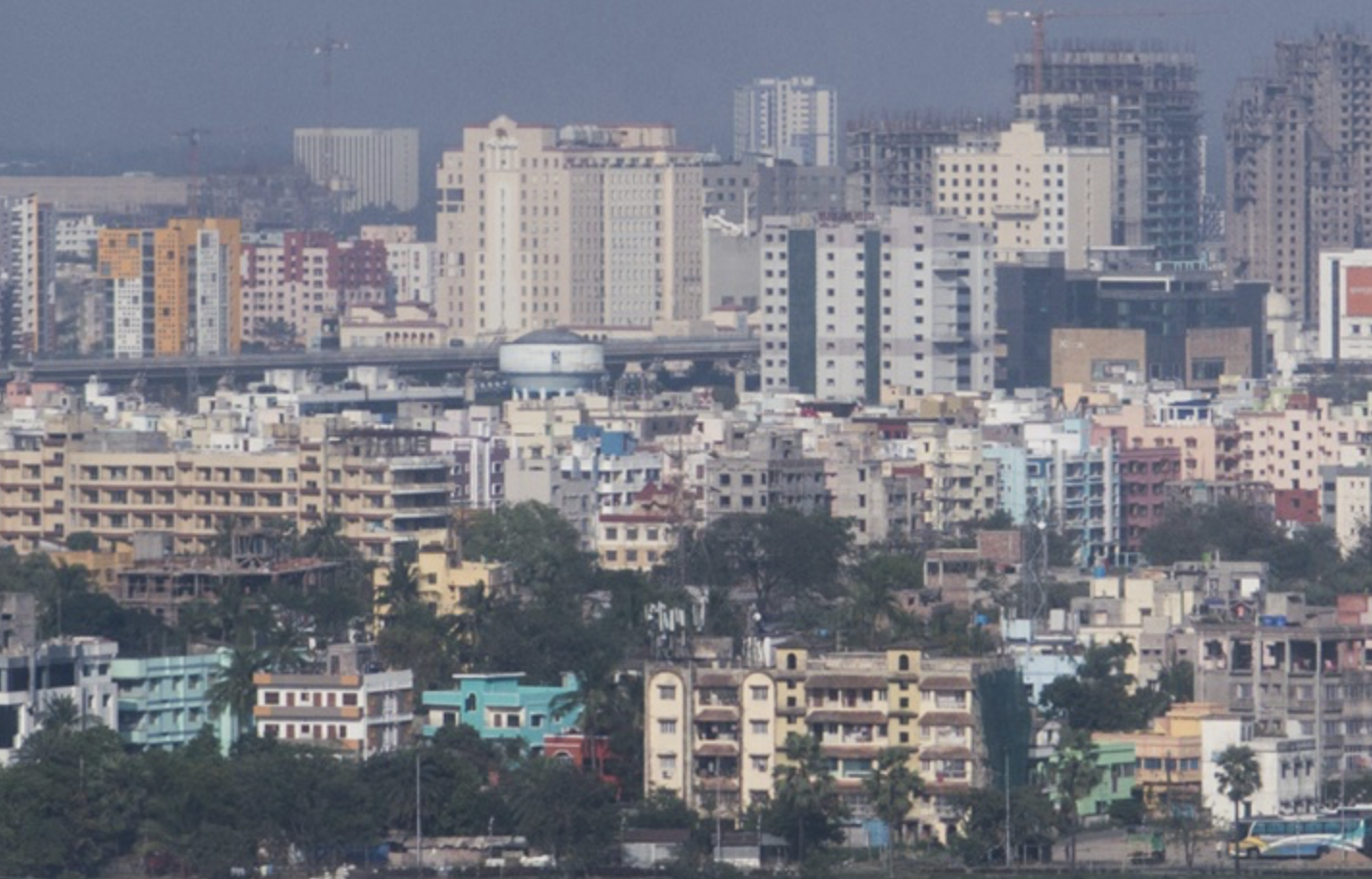Indian Cities See Momentum for Climate Action
The city is developing a Climate Action Plan (CAP), a strategic roadmap for mitigating environmental impacts and tackling climate change.

This article by Kundan Pandey originally appeared in Mongabay.
- The Maharashtra government recently directed 43 cities in the state to prepare Climate Action Plans, a trend that is increasingly seen among cities around the country.
- As cities face escalating climate risks, the Climate Action Plans serve as strategic roadmaps to address these challenges, protect vulnerable populations, and enhance urban resilience.
- While many cities are adopting Climate Action Plans, they are not legally binding like Master Plans and often lack integration with local government budgets and operations.
- Experts emphasise the need for local bodies to build internal capacity to ensure that that the plans translate into concrete actions and meaningful governance changes.
Latur, a city in the Marathwada region of Maharashtra with a population of around 500,000, received heavy rains on September 1, with 68.3 millimetres of rainfall in just 24 hours, causing loss of life and property. Historically known for its severe droughts, which were so extreme that in 2016, drinking water had to be transported there by train, Latur is now taking steps to address its climate challenges. The city is developing a Climate Action Plan (CAP), a strategic roadmap for mitigating environmental impacts and tackling climate change. This initiative follows a directive from the state government in July, mandating that all 43 cities in Maharashtra prepare CAPs. Maharashtra has been leading in this area, with Mumbai, the wealthiest municipality in the country, introducing India’s first climate budget in June after launching its CAP earlier.
This movement towards city-level climate planning is gaining momentum in the country. Kolkata has plans to create a CAP, while in March, Chennai committed to integrating its 2023 CAP into its Master Plan. Bengaluru launched its CAP in 2023 after completing its first-ever Greenhouse Gas (GHG) inventory, and in July, Leh’s administration organised a meeting to discuss a CAP for the city.
Cities will play a crucial role in climate action in India, with forecasts suggesting that 53% of the population—about 416 million people—will live in urban areas by 2050. These cities are also highly exposed to climate risks. Between 2036 and 2060, 33 of 57 major urban locations are expected to see increased extreme rainfall and flood risks, while 24 cities may experience decreased precipitation. Additionally, heat waves and warm nights are becoming more common, compounding the challenges faced by urban dwellers.
Jaya Dhindaw, Executive Program Director of Sustainable Cities at WRI India, which has supported several cities in making CAP, notes that Indian cities are increasingly vulnerable to climate risks and hazards. India ranks seventh most climate-vulnerable. As cities are economic engines contributing about 60% of India’s GDP, making them resilient to climate risks is essential. Moreover, almost half of the urban population, including many migrant workers, live in informal settlements and precarious conditions. CAP can help by identifying and providing guidance on how to protect these vulnerable groups by making cities more adaptive and resilient.
Sarath Babu MG, an urban practitioner with the Climate Centre for Cities at the National Institute of Urban Affairs (NIUA), explains that India began its climate journey in 2008 by launching the National Action Plan on Climate Change, which encouraged states to develop state-level action plans. “So far, climate-related decisions have been a shared responsibility between national and state governments. However, effective disaster resilience and adaptation efforts need to be driven at the local level, revealing a significant gap. The momentum for city-level interventions picked up after the Paris Agreement, coinciding with India’s various urban missions including the Smart City Mission in 2015. This initiative introduced an assessment framework titled ‘ClimateSmart Cities Assessment Framework’enabling cities to conduct self-assessments to measure their progress in mitigation and adaptation. This biennial framework is now in its third round, covering five thematic areas, 28 indicators, and about 98 data points. Following this, broader momentum emerged, with various funding agencies and bilateral organisations supporting these efforts,” he added.

Mathew Idiculla, a legal and policy consultant working on urban issues, and a visiting faculty at Bengaluru-based National Law School of India University, said that cities increasingly recognising climate change as a critical challenge is a positive development. “Historically, cities have approached environmental issues with a narrow focus, often under the umbrella of public health, addressing aspects like sanitation. Expanding this scope to include comprehensive climate action marks a significant shift in urban planning and governance,” he said.
Collaborations shaping cities’ climate action plans
Mumbai, along with Bengaluru and Chennai, is part of the C40 Cities network, a global coalition of nearly 100 city leaders committed to tackling the climate crisis. Delhi NCT and Ahmedabad are the other Indian cities in this network, which requires members to develop CAPs.
Shruti Narayan, Managing Director for Regions and Mayoral Engagement and Regional Director for South and West Asia at C40 explained that the current business plan of C40 (2021-2024) which outlines strategies and actions for cities to achieve climate resilience, sustainability, and carbon neutrality, has mandated the member cities to deliver CAPs aligned with the 1.5-degree climate target or risk losing membership. This requirement has led cities to make tangible commitments data-driven and evidence-based commitments toward climate actions. Narayan highlighted that these CAPs are built on comprehensive greenhouse gas emission inventories. “In India, for the first time, many cities understood their cross-sectoral climate footprints, making this a path-breaking exercise. The plans also include mapping climate risks,” she added. For instance, in 2018-19, Mumbai had the highest emissions among four major Indian cities, with 25.09 million tonnes of CO2e, closely followed by Kolkata at 25.04 million tonnes. Bengaluru emitted 17.81 million tonnes, while Chennai had the lowest emissions at 14.38 million tonnes for that period. Per capita emissions were highest in Mumbai at 2.0 tonnes, followed by Chennai at 1.9 tonnes, Bengaluru at 1.6 tonnes, and Kolkata at 1.5 tonnes, despite Kolkata’s overall emissions being nearly as high as Mumbai’s, reveals the Chennai CAP report.
Mumbai, which rejoined the C40 network in 2020 (after being a member in 2007), launched its first CAPin 2021, driven by the then environment minister for the government of Maharashtra, Aaditya Thackeray. Technical support for the plan came from WRI India, which also supported Bengaluru in preparing its CAP. Similarly, philanthropic and research organisations Community Jameel, J-PAL as well as C40 played key roles in Chennai’s CAP, while Ahmedabad’s 2022 plan was developed with help from the non-profit policy research organisation, Vasudha Foundation. The National Institute of Urban Affairs, under the Ministry of Housing and Urban Affairs, has also launched a City Climate Action Plan training manual in 2021.
Despite these positive steps, experts note that the initiatives are largely driven by international organisations or civil society rather than local administrations. Sarath Babu MG from NIUA points out that external agencies primarily support these efforts, not local governments due to financial and capacity constraints. Mathew Idiculla added that the organisations pushing or collaborating with cities are aiming to adopt these plans. Now, whether it actually goes into the way the city is actually run on an everyday basis is going to be a challenge.
But Narayan said that C40 provides a framework, but the plan has to be led by the local government. “The city is delivering and owning this, and that’s part of the requirement of our leadership standards. The city has to ensure that this is going to regularly update its climate action plans, also put in place monitoring, evaluation, and reporting systems so that they are continuously and consistently able to track their development,” she added.

The resource deficit in local bodies, a big barrier
The Global Protocol for Community-Scale Greenhouse Gas Emissions Inventories (GPC) standards were applied for the first time in an Indian city context in Mumbai during the process of developing its CAP. These global standards, measure emissions from the three largest emitting sectors in cities: stationary energy like buildings and industry etc., transportation, and waste. They assess all emission sources at the community and city levels, explains Jaya Dhindaw from WRI India.
She highlights a challenge for smaller cities progressing on Climate Action Plans: while tier-1 cities may have knowledge of CAP frameworks to follow, smaller cities lack such templates and resources. This capacity gap can result in producing inconsistent baseline emissions estimates. To address this, she added that there is a need to build capacity within cities and among the stakeholders who help develop these plans.
Idiculla noted that local bodies often lack the human and financial resources to hire experts, leading them to rely on external support. However, the problem extends beyond developing the plan. Execution of these plans will also face challenges at various levels. Local bodies need to develop some internal capacity to drive these plans effectively, he added.
Several reports have underscored the challenges urban local bodies (ULBs) face in terms of resources, both human and financial.
Sarath Babu MG points out that cities have planned Climate Action Plans before, but those efforts lost momentum due to financial constraints. A NIUA report noted that the Municipal Councils of Coimbatore, Rajkot, Siliguri, and Udaipur ratified their respective ‘Climate Resilient City Action Plans’ before 2021.
Hope without legal grounding
The ongoing efforts suggest that Indian cities may finally be preparing to tackle new era challenges, but doubts linger as CAPs lack legal backing. “CAPs are not statutory; they function more like guidelines and have no legal binding, unlike city master or development plans,” said Dhindaw.

The only legally binding documents for cities are the Master Plans, but local bodies have not consistently adopted or followed them, exacerbating urban issues such as infrastructure strain, pollution, and flooding. A NITI Aayog report notes that half of statutory towns and two-thirds of census towns lack master plans to guide their spatial development.
“Great ideas are out there, but nothing gets done,” said Idiculla. “City climate action and master plans often lack connection to the budget cycle of local governments. Effective plans need an implementation framework with clear actions, timelines, and funding. Without aligning plans, projects, and budgets, it’s just talk with no real impact.”
Dhindaw remains optimistic, noting that CAPs serve as valuable tools for uniting diverse stakeholders around a common climate agenda. While Master Plans are updated every 20 years, CAPs should be updated more frequently, to provide the right direction towards addressing the immediate impacts of climate change on urban life, she added.
License
Pandey, K. (2024). Indian Cities Witness a Growing Momentum for Climate Action. Originally published in Mongabay. Available under a Creative Commons Attribution-ShareAlike 4.0 International License. Minor changes made to original formatting.




